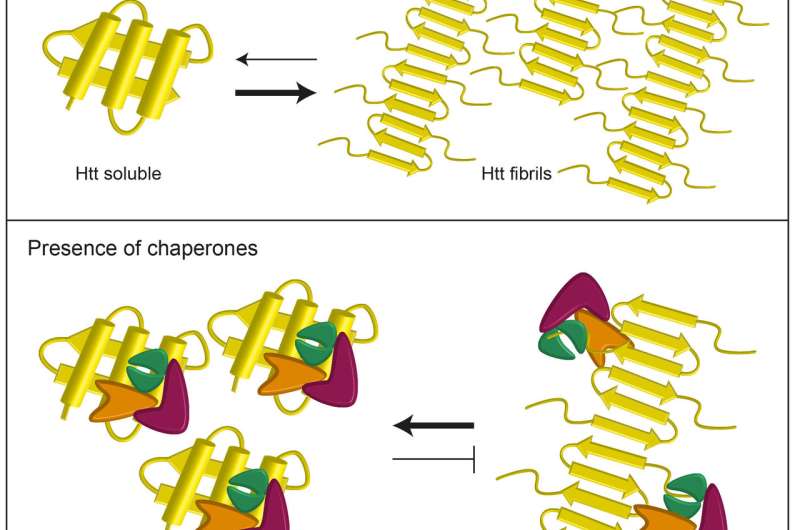Molecular chaperones shown to assist in the fight against Huntington disease

Huntington's disease is a neurodegenerative disease. It is always fatal. The disease is caused by a defect in the Huntingtin gene. To this day, no therapy will put a stop to the insidious disintegration of brain cells. Fortunately, scientists of the Leibniz-Forschungsinstitut für Molekulare Pharmakologie (FMP) in Berlin in collaboration with their peers working at the Max Delbrück Center for Molecular Medicine (MDC) and at the Charité University Hospital discovered a natural mechanism, which not only suppresses the build-up of pathogenic amyloid fibrils but also disaggregates them. The scientists declare that the newly discovered molecular chaperones may soon be crucial parts of new therapy approaches. Recently, they published their work in the EMBO Journal.
In the past, Huntington's disease was also called Saint Vitus' Chorea (chorea = dance). As of today, Huntington's disease, like the neurodegenerative diseases named after Alzheimer and Parkinson, is incurable. A mutation in the dominant Huntingtin (Htt) gene causes Huntington's disease. This distinguishes Huntington's disease from Alzheimer and Parkinson. The Htt mutation involves a DNA segment with extra repeats of the polyglutamine-coding CAG triplet. The greater the number of extra repeats there are of this polyglutamine-coding segment, the more prone is the Huntingtin protein to improper folding and aggregation into pathogenic amyloid fibrils. In the affected cells and brain regions, the long fibrous proteins keep accumulating. The protein aggregates interfere with many physiological functions. Finally, the disease process will lead to cell degeneration and cell death.
So far, there is no therapy for patients with Huntington's disease. In a new approach, scientists focus on reducing the amyloid plaque formation due to the presence of the Htt protein. So far, scientists still did not succeed in the complete suppression of the pathogenic process. It was also unclear whether the fibrils can be disaggregated once they have formed.
Chaperones Keep Order in the World of Proteins
Still, suppression and reversal of the Htt-fibril formation is obviously feasible. For the first time, scientists at the Leibniz-Forschungsinstitut für Molekulare Pharmakologie (FMP) in Berlin in collaboration with their peers working at the Max Delbrück Center for Molecular Medicine (MDC) and at the Charité University Hospital discovered a natural mechanism, which prevents the accumulation of pathogenic amyloid fibrils completely and can disaggregate already existing plaques inside the cells. A complex of three molecular chaperones is involved. Chaperones are proteins with abilities of helping other proteins to mature, to avoid improper contacts and to correct errors.
Dr. Janine Kirstein (FMP) reports: "We were able to show that the trimeric chaperone complex of Hsc70, DNAJB1 and Apg2 is able to suppress the Htt-fibril formation entirely! The same chaperone complex is also able to disaggregate the Htt fibrils. This plaque removal opens new venues for therapy approaches."
The FMP, MDC and Charité worked together on this pioneering achievement. You find a description of their work in a recent issue of the EMBO Journal. An innovative fluorescence-based Htt-fibril formation assay developed in the laboratory of Erich Wanker (MDC) enabled the scientists to test the impact of individual chaperones and chaperone complexes on the Htt-protein aggregation and helped to identify the key players. Moreover, the scientists also succeeded in demonstrating the relevance of the identified chaperones in induced pluripotent stem cells (iPSCs) obtained from patients suffering from Huntington's disease. Clinician Josef Priller (Charité) and Alessandro Prigione (group leader at the MDC) played significant roles in this part of the project. Yet another insight emerged from the joint investigations. The over-expression of the DNAJB1 chaperone (probably the limiting factor) of the three-chaperone complex results in a significant reduction of the Htt aggregation in cell cultures.
Planning Ahead: Screening for Active Agents
Group leader Janine Kirstein lets us in on plans for the discovery of a practical therapy approach: "These data also show the value of chaperones as pharmacological targets. In collaboration with the screening unit of the FMP, we plan to screen for active agents, which will specifically induce the three identified chaperones or boost their cooperation."
It is quite possible that chaperones play a role not only in Huntington's disease but also in other neurodegenerative diseases. Therefore, the scientists will extend their research also to other amyloid proteins such as Amyloid beta and tau in Alzheimer Disease or TDP-43 in cases of ALS."
More information: Annika Scior et al. Complete suppression of Htt fibrilization and disaggregation of Htt fibrils by a trimeric chaperone complex, The EMBO Journal (2017). DOI: 10.15252/embj.201797212





















